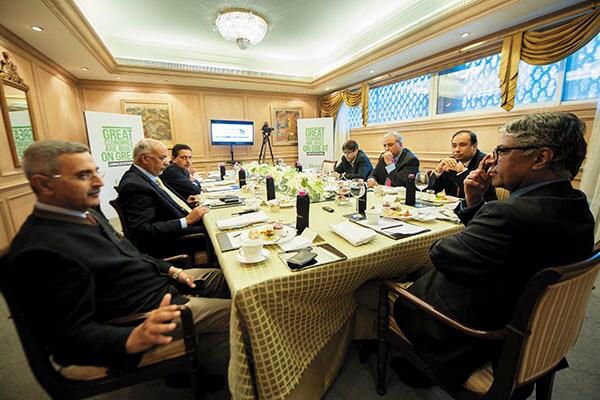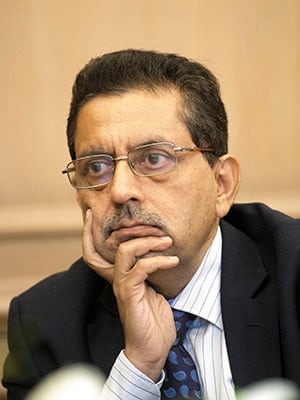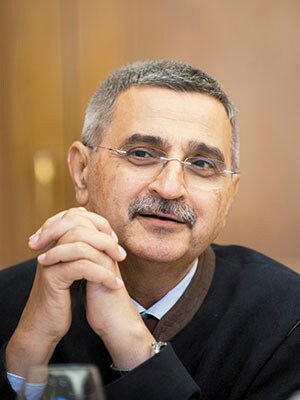
Going digital is a must to realise India's growth potential
Going digital is not an option, but a necessity to realise growth potential. However, it must be backed by proper infrastructure, according to key players in the sector
Prime Minister Narendra Modi is banking heavily on the ‘Digital India’ initiative that aims to make optimum use of technology to improve governance. The BJP-led government also intends to boost digital literacy in the country by providing broadband connectivity to remote areas at affordable rates. It wants citizens to have easy access to government services on their mobile platforms.
As part of the second season of the Forbes India CEO Dialogues: The Leadership Agenda, Himanshu Kapania, managing director of Idea Cellular, Sunil Mathur, MD and CEO of Siemens India, Bazmi Husain, MD of ABB India, CP Gurnani, MD and CEO of Tech Mahindra, and R Chandrasekaran, executive vice chairman of Cognizant India, discuss the challenges in implementing this ambitious plan. They believe Digital India can be a reality only if basic infrastructure is in place and regulatory issues are swiftly addressed. Excerpts from the discussion moderated by R Jagannathan, Forbes India’s editor-in-chief:
R Jagannathan: Mr Husain, what does Digital India mean to you and what should be the government’s priority in connection with that?
Bazmi Husain: Digital India should mean more growth. It should also mean that the ease of doing business improves and gets streamlined.
Sunil Mathur: As part of the ‘Make in India’ campaign, the prime minister talks of inclusive growth and improving the share of manufacturing from 16 percent to 25 percent of the GDP. This would mean about Rs 500 billion to a trillion of expenditure in the manufacturing sector. If this has to happen, India will have to become the world’s manufacturing hub at some point. It can only happen with digitisation, but we will have to provide high quality, precision equipment. The ‘power for all’ vision cannot happen without digitisation. It is the underlying foundation even for the smart cities programmes.
Jagannathan: In the field of energy, there has been a shift in policy towards renewables. Will digitisation play a greater role in that sector too?
Mathur: If India has to be a global player, we cannot be using technology of the past. We have to get there by using technology of the future. It’s about smart meters, grid and data management systems, managing and analysing the data, and using it to bring more efficiency into the system.
Jagannathan: Mr Chandrasekaran, is India still thinking analog rather than digital? Are you interacting with companies that are going hammer and tongs in the digital space?
R Chandrasekaran: I think so; there is lot of positive movement. Digitisation is not an option. For a country as diverse as India, if we have to solve our problems, digitisation is the answer. Otherwise, how are we going to educate our millions [of people]? Quality education cannot be delivered if we do not use technology. Do we have doctors and nurses in primary health care? We have to be innovative to tap technology and provide necessary assistance towards health care in remote areas. In the financial services, we had debated several decades ago whether we should computerise banks. Can we think of a bank without computers [today]? Similarly, digitisation is a necessary angel we need to latch onto to make sure we realise our potential as a country.
Jagannathan: Mr Gurnani, it is often said that since everything in India is broke, digitisation is the only answer. Is digital the only thing that will get us back [on track]?
CP Gurnani: You are right to some extent. For example, in the case of a public school system, if the information about whether a kid is getting a mid-day meal or not, if teachers are teaching and whether or not a municipal cleaner is cleaning the road is available and can be uploaded to a smartphone, the public can start acting on it.
Jagannathan: Mr Kapania, what should be the government’s priority for Digital India in terms of a policy thrust?
Himanshu Kapania: There have been long discussions about what has failed in India and very little regarding what has succeeded. Take mobility and its impact on Indian society: From an era of unconnected India, we have moved to one of a connected India; now we move from the era of a connected India to that of a broadband India where we are discussing internet and equality of internet for all. There are 6-7 million Indians who use broadband services. I was in China recently where I met their government officials and four top telecom operators. They said they had spent $35 billion in 2014 to build mobile broadband infrastructure for 4G services. India had spent $32 billion. But they spent this money on capital equipment to roll out 4G, while India spent $29 billion to buy spectrum and $3 billion towards capex. So the furore in India is regarding call drops and the ability to stay connected.
The challenge in India is that somebody in the ecosystem is sucking away the money to not allow the supply to build up. But it is only a matter of time before infrastructure catches up in the broadband space.
In three to four years, at least 700-800 million people in India will see high-speed broadband of 5 to 10 Mbps. It will be a reality. But the transition from one technology to another will be painful. Once the broadband services and devices are available, there will be dormant penetration. A World Bank estimate says with 10 percent dormant penetration, GDP levels will improve at an average of 2.5 percent. Once broadband connectivity improves, IT services will become more important. The large innovation will be the arrival of broadband and payments [solutions].
The banking system largely serves only high net worth individuals; 600 million Indians are unbanked. If India has to have a big digital programme which is successful, the entire payment system has to be transitioned and a massive micro-payment system has to evolve.
Chandrasekaran: I feel four ‘Ps’ are very critical for the digital programme to be successful. The first is the [technology] platform; the second, business processes—government to citizens, consumer to consumer and business to consumer dealings must undergo a change. The third layer is people; one needs to expand digital literacy across India. The government will have to think about how to make millions of Indians digitally literate. Skilling will be critical. If all this has to be put in place, the government cannot do it alone. There has to be a private-public partnership. We are all excited about the opportunities it can open up for services companies. The startup ecosystems are also waiting.
Jagannathan: Mr Husain, is there a sense of unrealism? We are talking about a rocket [digital revolution] but on ground, we have a power system that is like a bullock cart tied to this rocket. Is there a mismatch between the real infrastructure that needs to be created and the virtual infrastructure that is necessary to ride on top?
Husain: It is not unreal, but we are not ready yet. Many things need to be done, the most basic being [improving] the energy distribution system. The electrical system is also going through its transformation of digitisation. This is also a painful transformation. On the IT side, India does not have a cyber security policy. The only cyber security policy in India came out in 2013 because of the [Edward] Snowden issue. We need to prepare the ground better before we make something available.
Gurnani: The biggest benefit of a digital India will be if we can get away from intermediaries. The purpose of technology is to be able to cut off the layers and make the process transparent. Prime Minister Narendra Modi has recognised that. Mobility and broadband and ecommerce have yet to scratch the surface.
Mathur: While we all get carried away with digitisation, we need basic infrastructure. We cannot have trains running at 29 kilometres an hour transporting food from the north to the south. We have to correct our infrastructure, railways and electricity. Digitisation will come as stage two, but it will not come unless we have basic infrastructure in place.
Chandrasekaran: I agree partly, but bringing up physical infrastructure [swiftly] will always be a challenge; we can overcome it using digital infrastructure.
Mathur: But how will you leapfrog digitisation into an area which has eight hours of power cuts?
Husain: The impression should not be that there is something against digitisation. We should not just jump on the train and be left behind. We have to understand that first the country needs basics to be put in place, which includes physical infrastructure and regulatory issues. We have to understand that digitisation becomes an enabler of a better quality of life not a giver. The problem is that this country has no privacy policy. The government can do what it wants relating to data and there is nobody to stop it. We should be concerned that all this information will be available to be hacked into by anyone.
Jagannathan: We have the cart and horse going in different directions. Mr Kapania, who does digitisation threaten or affect negatively?
Kapania: None, in fact. From an economic perspective, digitisation can only take the country forward. Will technology disrupt some sectors and their way of working? It is a natural evolutionary process. None of us can live in the old paradigm. Any sector or company which is not adopting digitisation in its own way will get affected. Considering the banking system, India is largely a cash economy; the total transactions that happen outside the system are multiple times more than within the system. Digitisation and digital wallet will change and bring the parallel economy into the mainstream. Some sectors have to be worried about the pace at which they are moving.
One is the media sector. If digitisation means slower growth of published newspapers or TV channels, so be it. Media will have to evolve to adopt digitisation rather than be left behind.
Are media companies seeing internet companies as new competition? Today, 20 of the top 50 global companies are in some way linked to the internet world. If companies are not ready for a [digital] change and if they believe they have a traditional way of working, they will have no place to hide.
Jagannathan: Mr Gurnani, as digitisation comes in, is there scope for social tension, as people will need to re-skill or re-invent themselves?
Gurnani: The people who do not adapt will be left behind. I am a huge proponent of what consultants call ‘digical’ [digital + physical]. [He cites the example of booking a flight through MakeMyTrip.com, which also has counters at airports to sell taxi services or hotel bookings]. In India, there will be a ‘digical’ economy and from an economic perspective, that is the way to go.
Jagannathan: Mr Husain, how do you see the ease of doing business in a digital age? Is it happening?
Husain: It is moving in that direction, but it will only accelerate.
Mathur: We don’t know the technologies of tomorrow. The skills which we are teaching our children today could be irrelevant tomorrow.
Gurnani: The government has improved dramatically [in adopting technology]. The more transparent we become, the better are our chances of being successful.
Chandrasekaran: [The World Bank ranks India 142nd out of 189 nations in the ease of doing business]. The promise of digital technology will make it easier. We have come a long way in tax filing, as individuals and even as corporates.
Mathur: It is inevitable that it will happen. It has already begun. Approvals have been simplified. But I don’t think we have scratched the surface yet; the potential is massive.
Jagannathan: What can we learn from other countries about the digital experience?
Kapania: We have missed a few things relating to digitisation. But the new big journey, relating to devices, is about to begin. Just like what happened with IT businesses—where India took the lead—with the right vision, infrastructure and soft power, India can develop large-scale linkages between IT and mobility, automobiles, real estate, banking services. We lost opportunities relating to the messaging revolution.
Chandrasekaran: We have to be innovative in the way we introduce [digital] services. We see requests for proposals from overseas countries on how we implemented the UIDAI project.
Husain: One of the challenges for India is that we spend $17 billion on research and development. In comparison, China puts in ten times that amount. The bang for the buck seems to be greater out here but we need to leverage more from what we are doing today. Regarding innovation, we have a greater separation between industry, the academia and the government than any country which has been more successful.
Mathur: We need to improve implementation; we still have a disconnect between the head and hands. Are we spreading ourselves too thin? Should we take one step at a time in digitisation, taking one project at a time and completing it first? India will get there quicker if we digitise in a structured and planned manner.
(This story appears in the 30 November, -0001 issue of Forbes India. To visit our Archives, click here.)








